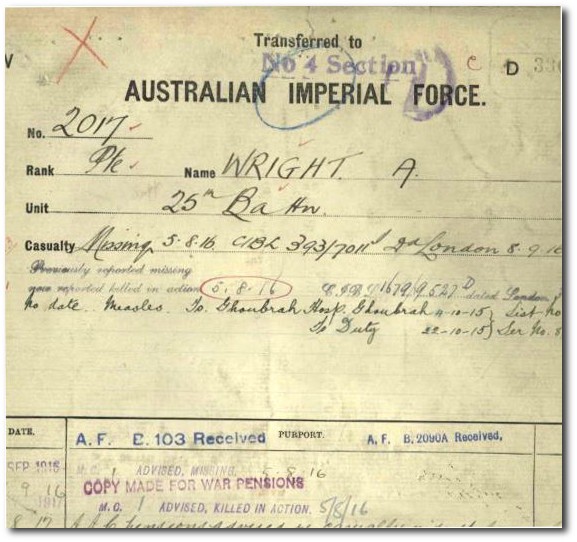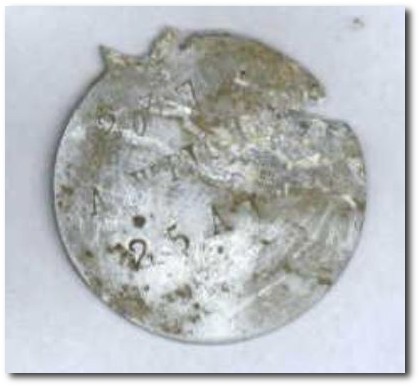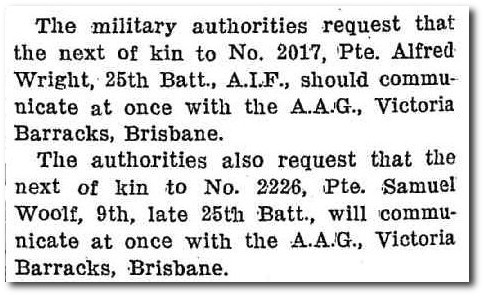
Extract from Service Record, for Alfred Wright. Courtesy National Archives of Australia, Series B2455, Item ID 3447009
Indigenous Australian, Alfred Wright, 25th Infantry Battalion
Alf Wright (1894-1916) was working as a shearer in St George, Queensland when he volunteered to serve for his country in June 1915. Just 21 years old, he soon found himself travelling from Mitchell to the training camp at Enoggera, Brisbane, assigned to the 3rd Reinforcements for the 25th Infantry Battalion.
With barely 6 weeks basic training Alf left Brisbane aboard HMAT Kyarra on 16 August 1915, and like many men of his comrades, he contracted measles during the voyage. When the ship arrived in Egypt in early October Alf was admitted to the Choubra Hospital in Cairo, which the Australian military had taken over for the treatment of troops with infectious diseases.
Alf remained quarantined for 3 weeks before being discharged, and finally joined the other reinforcements encamped on the island of Mudros, just off the Gallipoli Peninsula, early in December.
Preliminary plans to evacuate men from Gallipoli had already begun, but on 8 December 1915, orders were received by General Birdwood to evacuate positions at Suvla Bay and Anzac Cove, thus sparing the men the prospect of defending positions through the winter.
Alf returned with his comrades to Alexandria early in the new year, where the Australian battalions were reorganised, some men remaining with their original units others joining newly formed ones.
Alf sailed for France with the 25th Battalion arriving at Marseilles 19 March 1916 where they marched into Sadi Camp and were greeted by the French General in Command, Marseilles Defences. He expressed his great pleasure "at the soldierly bearing and excellent physique of the men".
From here, the 25th was transported by train, north to the battle fields, arriving at Thiennes, then marching into their camp on Morbeque Road.
Between 25 July and 7 August the 25th Battalion was engaged in its first major battle at Pozieres. They suffered heavy casualties during night-time attacks by the enemy, receiving 'terrific shelling'. Many were killed or wounded, on the eve of 5 August 1916, and 178 'other-ranks' were reported as missing.
Alf Wright was included in this statistic, and later named as killed in action. It would be many years before Alf Wright's body was recovered and identified, as part of the ongoing work by the Commonwealth War Graves Commission (CWGC).

Identification disc found in 1930s. Image courtesy National Archives of Australia, Series B2455, Item ID 3447009, page 11.
Like many WW1 battlefields, the area where Alf Wright was killed, was later obliterated in 1918 during heavy German shelling. At the end of the war the Commission was tasked with searching for the graves and remains of the war dead and conducting the battlefield exhumation and reburials which resulted.
It was not until 1930 that Alf Wright's body, along with his identification discs was located, exhumed and reburied at Serre Road Cemetery, Beaumont Hamel.
You can see from the official documents attached to his service record, the meticulous recording of detail, which provides relatives with a clearer idea of where their loved one died in service of their country.

'Next of kin wanted'. National Leader, 17 August 1917, p.2
When Alf Wright's service medals were issued in the 1920's they were unable to locate his named next-of-kin Thomas Hawke/s. They placed a notice in the newspapers of the day asking family members to come forward, but the last page of his service record shows that they were not successful and 'Untraceable'.
** Thomas Hawkes was living near Longreach in the 1930s, along with his wife Emily Wright, and sons James and Thomas jnr.
Read more ...
- Service record: WRIGHT, Alfred, National Archives of Australia. Series B2455 Item ID 3447009
- Embarkation roll: 3rd Reinf. 25th Infantry Battalion
- Roll of honour: Australian War Memorial
- Red Cross Wounded and Missing Files
- AIF Unit diaries: 25th Infantry Battalion
- Commonwealth War Graves Commission
- War Graves Photographic Project
- John Jack Wright, 118 years old. Naromine News and Trangie Advertiser, 28 February 1936, p.10
- Next of Kin Wanted. National Leader, 17 August 1917, p.2
The information in this blog post has been researched by State Library staff and volunteers, it is based on available information at this time. If you have more information that you would like to share or further research uncovers new findings, this post will be updated.
Comments
Your email address will not be published.
We welcome relevant, respectful comments.